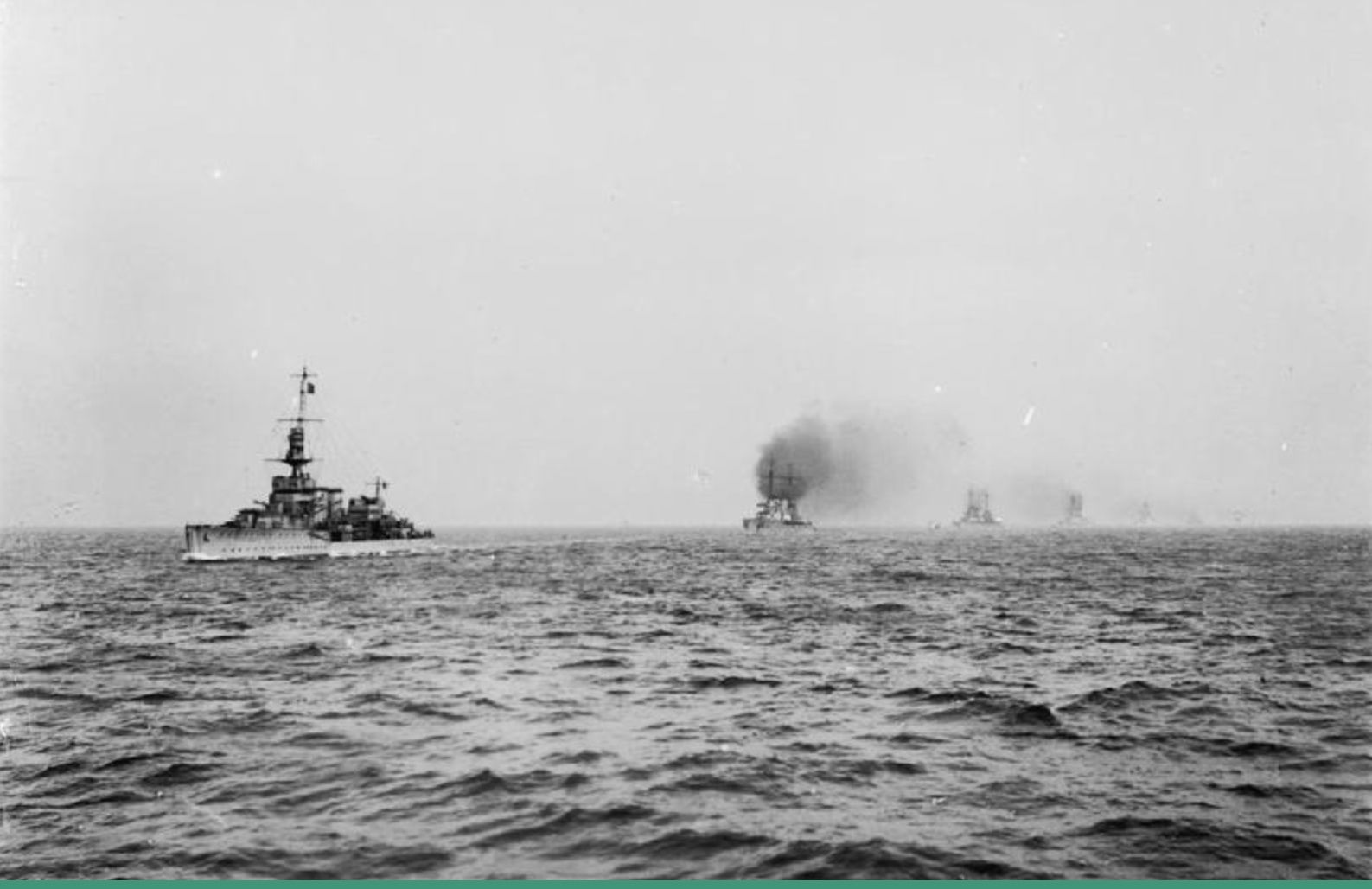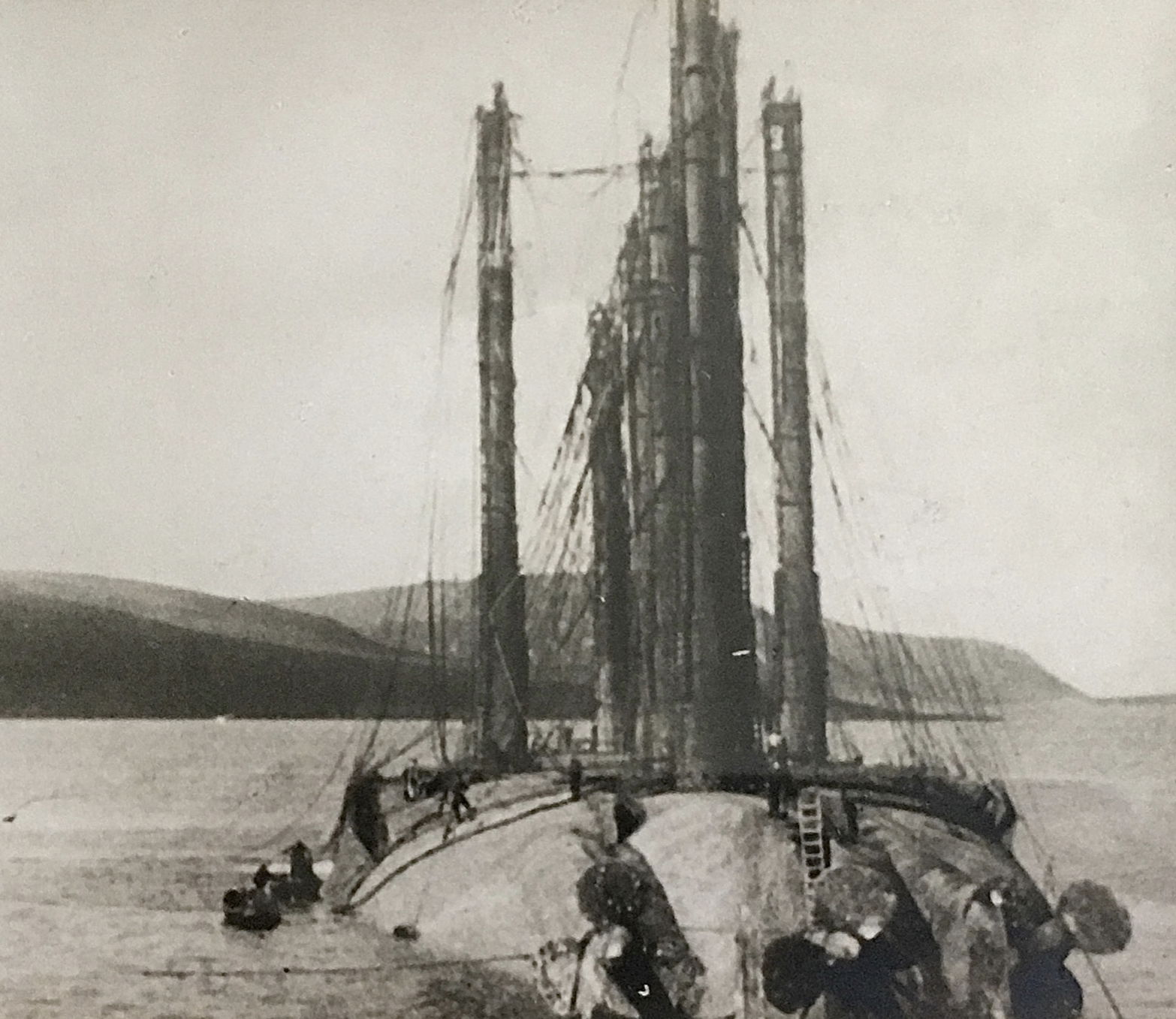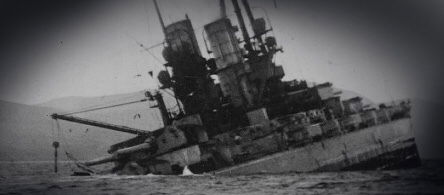The German Surrender

Germany signed the Armistice with the Allies on 11 November 1918. Article XXI of this ordered the surrender of all German U-Boats, over 200 were handed over, mostly within the next two weeks. Article XXIII involved the handing over and internment in Allied or neutral ports of seventy-four named warships, their fate to be determined by the peace negotiations.
Rear-Admiral Ludwig von Reuter was given command of this force and used Friedrich der Grosse as his flag ship. Apart from the unpleasant task of surrendering a powerful undefeated fleet he also had major problems with his men, many of whom were mutinous with communist tendencies and he had to ensure that his fleet was disarmed.
On the 19 November the German force set sail for the Firth of Forth where the British would check that the disarmament was complete before moving to other ports to be interned. The torpedo-boat V30 strayed off course and was sunk by a mine. The Germans arrived at the Firth of Forth on the morning of 21 November and were met by an Allied force of 250 ships under Beatty which included most of the Grand Fleet, an American Battleship squadron and representatives of other navies with a total of forty four capital ships. The Allied guns were trained fore and aft but the gun crews were ready for action. At 3.57 p.m. the German flag was ordered to be hauled down and was not hoisted again until the ships were scuttled.
The British checked each ship thoroughly to ensure disarmament and were apparently impressed with the quality of the ships, if less so by the crews. From the 22-26 November the German ships left in groups for Scapa Flow, all having arrived by 27 November.


German battlecruisers at Scapa Flow. The German crews were confined to ship, a situation they were not used to. German crews often lived on shore and spent relatively short periods on their ships, unlike the British who lived on board when in port. This enabled German ships to benefit by having fewer doors in their bulkheads but they were less habitable than the British ships. |
The Germans were not happy at being interned at Scapa Flow as they felt that they should have been interned in a neutral port, and that the British were breaking the spirit, if not the word of the Armistice. They were however in no position to do anything about it.
By mid December the 20,000 crew who who had sailed the ships to Scapa were reduced to a caretaker crew of 200 per battlecruiser, 175 per battleship, 80 per light cruiser and 20 per destroyer (torpedo-boat) leaving a nominal total of 4,565 plus 250 officers and warrant officers, although the exact actual figures are thought to be higher. This was considerably more than the British thought necessary but for once the German view prevailed.
There were considerable discipline problems amongst revolutionary elements in the German crews, with c150 trouble makers being sent home and Reuter changing his flag to the cruiser Emden. In June 1919 the crews were reduced to Royal Navy caretaker levels, 75 per battlecruiser, 60 per battleship, 30 per light cruiser and whatever was necessary for the destroyers, a total of about 1,700.
During this time the peace talks had been dragging on, with several extensions to the Armistice, and the Treaty of Versailles was not ready until May 1919. The Allies were divided over the fate of the ships with many countries wanting a share, whilst the British, the major naval power at the time, were less keen to boost the strength of rival navies. The treaty involved the surrender of the interned ships.
When Reuter heard this he became concerned that the British would seize the ships without notice and started active planning to scuttle the fleet, although he had been considering the option for some time. The British were also well aware of the danger and had plans for armed seizure of the ships. The German officers planned the scuttle, the troublesome crews were not told but in many cases worked out what was going on by watching the officers making preparations, many of the crews were then told.

Bayern as raised in 1933. She fetched a scrap value of £110,000 nearly half of which was profit. The salvage operations on the various ships started in the early 1920's with most of the ships having been raised by the late 1930's. Since then fragments of ships have been raised and since Hiroshima they remain an important source of quality radioactive free metals necessary for certain types of sensitive scientific instruments. |
On the morning of 21 June the British battleships at Scapa Flow, the First Battle Squadron, with their escorts left for exercises. At 10.30 am on 21 June Reuter signalled the fleet "Paragraph eleven. Confirm." - the code for immediate scuttle. It took a while for the message to get around the fleet and it was an hour before all the ships acknowledged the signal. The only British warships present were the destroyers Vespa and Vega as were a couple of depot ships and various trawlers and drifters. They signalled the First Battle Squadron which returned to base at full speed. The British managed to beach the Baden and the cruisers Nürnberg, Emden and Frankfurt, all the other major units sank. In the confusion nine Germans were shot dead, the last kills of WWI, although nobody was drowned, on the whole light casualties under the circumstances.
Over 400,000 tons of modern warships were sunk, the largest loss of shipping in a single day in history. Publicly the British were outraged but in private there was a sense of relief that the problem of what to do with the fleet was now ended. Considerable efforts were made by British Intelligence to prove that the scuttling had been authorised by Berlin but they never found any proof.

Bayern sinking. She and her sister, Baden, were the most powerful German ships of the war, being armed with 15in guns. They were the first German ships to have equivalent firepower to British ships, rather than smaller guns but thicker armour. They had hybrid propulsion systems with a mixture of coal and oil , less efficient than the all oil systems then in use by the British, but they were still the fastest German battleships of the war. |


